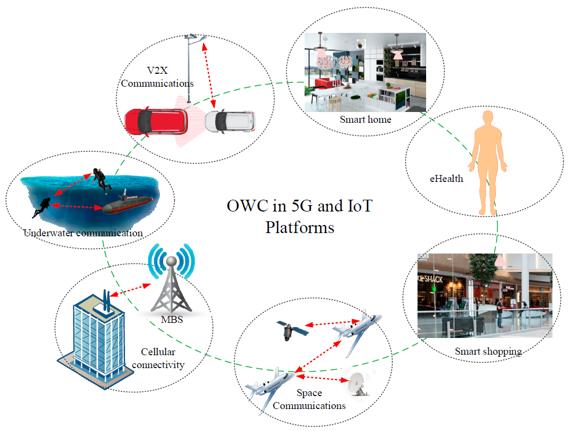Research domain
Digital Signal Processing, Optical Wireless Networks, 5G & B5G, Machine Learning and Big Data, and Vehicular communications.
The general objective of this proposal is to train advanced human capital through distributed work in universities in South America and France, researching 5G&B5G Technology in Underground Vehicle Communications using artificial intelligence (AI), optical and radio frequency communications (OWC/RF). The project will focus, in particular, on the different applications of mixed wireless communications systems that can be used to enable future applications of wireless communications in mobile underground environments. For this, many challenges have to be overcome to ensure reliable data transmission according to the requirements of each application in harsh environments such as operations in mines, tunnels, or subway parking lots.
As a result of the growing research on fifth generation (5G) New Radio (NR) systems, different applications have been developed using optical wireless communications (OWC) and radio frequency (RF) technologies as a key factor. These technologies are capable of transmitting wireless data with a high data rate, and for 5G and beyond systems, the goal is to bring all processing tasks to the cognitive level through machine learning (ML)-based algorithms that are data-driven. In addition, by using mixed OWC/RF channels, accurate indoor localization can be achieved in environments where one of the systems may fail or under perform or be an unfeasible alternative due to channel characteristics. Moreover, mixed OWC/RF wireless technologies can be used in vehicle-to-infrastructure (V2I) and vehicle-to-vehicle (V2V) communication providing a feasible technology for the development of autonomous vehicles for underground environments.
The applications mentioned above are just a few of the broad spectrum of research topics that can be encountered and the project will mainly focus to support the research collaborations in 5G & B5G Technology based on artificial intelligence for Underground Vehicles Communications with OWC/RF between research teams from Chile, Ecuador and France; promote the participation, human capital training and formation of young researchers and scientific results diffusion.
This project aims to strengthen scientific collaboration between research teams from Chile, Ecuador and France; promote the participation, human capital training and formation of young researchers and scientific results diffusion; around the field of wireless communications based on 5G &B5G as an enabling technology for future underground wireless vehicular communications networks. It is built around scientific researchers from South America and France, working multidisciplinary on different applications of 5G & B5G communications systems using OWC/RF, such as high data rate wireless communications networks, indoor positioning and vehicular communications. This project is built around a first kick-off meeting in Nancy.
During the execution of the project, it is expected to carry out the mobility of doctoral students and several postdoctoral researchers, as well as scientific transfer with companies related to mining, mobile telephony, the vehicle industry, among others. As far as possible, dissemination activities will be carried out for academic training. In the intermediate stage, meetings will be held in Ecuador and Chile, and a final meeting is proposed in Nancy, France, to summarize the team's results to be shown in the final report and to promote the results in a scientific workshop. We also hope to develop other collaborations and joint project applications.

The STIC-AmSud-supported project has achieved remarkable progress in visible light communication (VLC), machine learning (ML), and wireless network technologies from 2023 to 2025, as demonstrated by 109 peer-reviewed publications. This initiative has seamlessly integrated scientific rigor with practical solutions, tackling real-world challenges faced by industry partners—such as demand-driven ventilation for enhanced energy efficiency and safety—while cultivating a vibrant, interdisciplinary research ecosystem. These efforts have not only driven technological innovation but also set the stage for impactful future collaborations aimed at advancing applied solutions across diverse fields. To contextualize these achievements, the project addressed critical problems outlined in the video Opportunity, focusing on innovative VLC systems for applications like IoTbased patient monitoring in hospitals, sustainable farming under varying atmospheric conditions, and underground mining communications through hybrid VLC/RF and nonline- of-sight (NLOS) approaches. Advanced ML techniques, including Extreme Learning Machines (ELM) and neural networks, have been pivotal in optimizing fingerprint classification, detecting epileptic seizures via EEG, and predicting cardiovascular diseases in challenging environments like tunnels. Furthermore, the project has enhanced 5G and mmWave network optimization, developed energy-efficient traffic prediction models, and pioneered collision warning systems by integrating ML with decentralized sensing, thereby contributing to smart agriculture, vehicular safety, and industrial automation. These findings, disseminated through high-impact journals and conferences, highlight the project’s transformative role in interdisciplinary technological innovation, with a particular emphasis on demand-driven ventilation solutions.